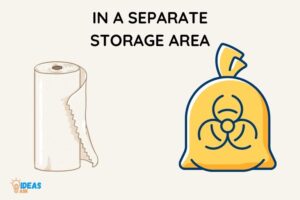Can You Use Paper Towels in a Dehydrator? Yes, Safety & Use!
Yes, you can use paper towels in a dehydrator as long as you follow certain safety precautions and use them correctly to avoid any potential negative effects on the food or the appliance.
Paper towels can be used in a dehydrator to help absorb excess moisture from the food, especially when dehydrating items with high water content like fruits, vegetables, or herbs.
Using paper towels can speed up the dehydration process and prevent the food from sticking to the trays.
However, care must be taken to avoid any potential risks associated with using paper towels in a dehydrator.
When using paper towels in a dehydrator, it’s essential to select an appropriate and high-quality product.
Using unbleached, non-toxic, and food-grade paper towels can help prevent the transfer of any unwanted chemicals onto your food.
Furthermore, you should cut the paper towels into the proper size to fit your dehydrator trays without blocking the air circulation.
Using Paper Towels in a Dehydrator:
| Step | Instructions |
|---|---|
| 1 | Select the appropriate grade of paper towel. The quality and durability will depend on the food item you’re dehydrating |
| 2 | Cover the dehydrator tray with paper towels. Ensure all areas are covered to prevent food from falling through |
| 3 | Place the food item on the paper towel. Arrange in a single layer to allow even dehydration |
| 4 | Place the tray in the dehydrator. Depending on the type of food, certain temperatures and times will apply |
| 5 | Check the food periodically. The paper towel will absorb excess moisture, but make sure the food is drying properly |
| 6 | Remove the food once completely dehydrated. Allow it to cool before consuming or storing |
| 7 | Clean the dehydrator trays. After removing the paper towels, wash the trays thoroughly for next use |
Key Takeaway

Five Facts About Using Paper Towels in a Dehydrator
Understanding The Basics Of Dehydrator And Paper Towels
Dehydrators are great for preserving fruits, vegetables, and meats. Written below are the key points to help you understand how they work and the importance of paper towels in the dehydration process.
Working Principles Of A Dehydrator
Here are some important things to know about how dehydrators work:
- Dehydrators use low heat and a fan to reduce the moisture content in food.
- As the food dries, the water is evaporated, which is then removed by the fan.
- The low heat and constant airflow ensure that the food dries evenly without getting cooked.
The Role Of Paper Towels In The Dehydration Process
Now, you might be wondering what role paper towels play in all of this.
Well, paper towels are important in a dehydrator in the following ways:
- Paper towels help to absorb excess moisture from the food being dehydrated, which can speed up the drying process.
- The moisture removed by paper towels reduces the chances of mold, bacteria, and fungi from growing on the dehydrated food.
- Paper towels help in eliminating the need to clean the dehydrator tray itself, sparing you the hassle and reducing the potential for contamination.
What Are The Different Types Of Paper Towels That Can Be Used In A Dehydrator?
It is crucial to ensure that the paper towels you use in a dehydrator are food-safe and appropriate for the task.
Here are a few types of paper towels that can be considered:
- Natural paper towels are unbleached and free from chemical treatment and are an excellent choice for those who prefer environmentally friendly products.
- Heavy-duty paper towels are thicker and can withstand the weight of heavy and liquid-soaked foods without tearing.
- Commercial-grade paper towels are preferred by many professional chefs as they have enhanced moisture-holding capacity and do not leave residues.
Using paper towels in a dehydrator can make the process smoother and quicker. However, be sure to choose an appropriate type of paper towel and ensure that it doesn’t come in contact with heating elements.
Can You Reuse Paper Towels In A Dehydrator?
Can You Use Paper Towels In A Dehydrator?
If you’re an avid home cook, chances are you’ve invested or are considering investing in a food dehydrator.
It’s a great tool to have for drying fruits, vegetables, and even meat, making them last longer while retaining their flavour and nutrients.
However, one question that often comes up is whether it’s safe to use paper towels in a dehydrator. We’ll explore this topic in detail.
Can Paper Towels Withstand Heat And Humidity?
Before delving into the question of whether paper towels can be reused in a dehydrator, it’s worth considering whether they are suitable for this purpose in the first place.
Can paper towels stand up to the heat and humidity produced by a dehydrator?
It depends. While some paper towels are designed to be durable and even heat-resistant, most are not.
If you are planning to use paper towels in a dehydrator, make sure you choose ones that are high-quality, thick and absorbent, and can withstand the temperature and humidity range of your dehydrator model.
The Impact Of Reusing Paper Towels In A Dehydrator
Now, on to the main question: is it safe to reuse paper towels in a dehydrator? It’s not recommended.
While it may be tempting to reuse paper towels to save money and waste less, there are several downsides to doing so:
- Reusing paper towels can introduce bacteria and other microorganisms into your dehydrated food, putting your health at risk.
- Used paper towels may have absorbed residues from previously dehydrated food, compromising the taste and quality of your new batch.
- Over time, reusing paper towels can cause them to break down and release debris or fibres that can contaminate your food.
Risks Associated With Reusing Paper Towels
To further convince you to avoid reusing paper towels in your dehydrator, here are a few additional risks to consider:
- Old paper towels may harbour mould, which can grow in the moist and warm environment of a dehydrator.
- Certain types of paper towels may contain harmful chemicals or dyes that can leach into your food and cause health problems.
- Even if you thoroughly clean and sanitize your paper towels between uses, there is still a risk of cross-contamination from bacteria or allergens.
While paper towels can be useful in a dehydrator in certain circumstances, it’s best to avoid reusing them for multiple batches.
Instead, invest in some high-quality, food-grade dehydrating sheets or silicone mats that are specifically designed for use in dehydrators.
This will ensure the safety, quality, and longevity of your dehydrated food, as well as provide peace of mind.
Q2: How Much Paper Towel Should Be Used When Drying Fruits And Vegetables?
Dehydrating fruits and vegetables is a great way to preserve them for a length of time without adding any preservatives.
An important component of the process is proper preparation, including the use of paper towels when necessary.
Let’s explore the perfect amount of paper towel needed for dehydrating different fruits and vegetables.
The Perfect Amount Of Paper Towel For Dehydrating Different Fruits And Vegetables
Dehydration requires the use of a paper towel to blot excess moisture from fruits and vegetables before drying. The perfect amount of paper towel needed is based on the fruit or vegetable being dehydrated.
Here’s a list of the most common ones along with the ideal amount of paper towel:
- Apples: One piece of paper towel.
- Tomatoes: A thin coating of oil, and one paper towel for every two tomatoes.
- Zucchini: Two pieces of paper towel.
- Pineapple: Three pieces of paper towel.
Using More Than The Necessary Amount Of Paper Towel
While it’s essential to use paper towels when dehydrating fruits and vegetables, it’s equally important not to use more than the optimum amount.
Using extra paper towel than necessary may cause the following:
- Uneven dehydrating that may impact the fruits and vegetables’ quality.
- Additional moisture in the environment leading to high humidity levels in the dehydrator.
- Extra waste of paper towels and environmental pollution, as well.
Using Less Than The Necessary Amount Of Paper Towel
Using less paper towel than the required amount when dehydrating fruits and vegetables also has drawbacks, such as:
- Insufficient removal of moisture, leading to the growth of bacteria, yeast, and mold on the fruits and vegetables.
- Reduction in the shelf-life of dehydrated fruits and vegetables.
- Undetermined results, especially with specific fruits and vegetables that require precise moisture removal.
So, it’s critical to use the optimum amount of paper towel needed to dehydrate different types of fruits and vegetables.
Paper towels are an essential part of dehydrating fruits and vegetables, and using the right amount can make all the difference in the quality, shelf-life, and taste of the end product.
With the information above, you can dehydrate your fruits and vegetables with the perfect paper towel amount, resulting in excellent and healthy snacks for you and your family.
Advantages Of Using Paper Towels
Dehydrating fruits and vegetables is an easy way to preserve them all year round. Dehydrators are effective in drying out moisture from fruits, vegetables, and meats.
Many people wonder if they can use paper towels in a dehydrator. In this blog post, we’ll explore the advantages of using paper towels in a dehydrator.
Absorb Moisture From The Fruits And Vegetables
Using paper towels in a dehydrator can absorb moisture from fruits and vegetables during the dehydration process.
This is an essential aspect of dehydrating food for preservation purposes. The moisture in fruits and vegetables can cause them to spoil, even when dried.
The dehydration process removes water from food, and using paper towels helps absorb that moisture.
- Paper towels are porous and absorb moisture effectively
- Different paper towels absorb moisture at different rates
- It’s essential to use a good quality paper towel for effective moisture absorption
Helps In Making The Dehydration Process Fast And Hygienic
Using paper towels in a dehydrator allows for a faster and more hygienic dehydration process. The paper towels help to remove and absorb excess moisture from the food, resulting in faster dehydration times.
Additionally, paper towels also help to keep the dehydrator clean and free from any bacteria.
- Paper towels reduce the chances of bacteria growth by keeping the dehydrator dry
- It’s best to replace the paper towels during the dehydration process to maintain cleanliness
- When using paper towels in a dehydrator, there’s no need to wash trays afterward, saving time and effort
Cost-Effective Way Of Dehydrating Foods
Using paper towels in a dehydrator is a cost-effective way of preserving fruits and vegetables.
Rather than purchasing specialty trays that are designed to absorb moisture, using paper towels is a less expensive option that gets the job done just as well.
- Paper towels are readily available and affordable
- There’s no need to purchase additional specialty trays
- Using paper towels in a dehydrator is an effective and efficient way to preserve food
Using paper towels in a dehydrator is an easy and effective way to absorb moisture from fruits and vegetables during the dehydration process.
They’re cost-effective, keep the dehydrator clean, and make the process faster and more efficient. Give it a try next time you’re preserving your favorite fruits and vegetables!
Disadvantages Of Using Paper Towels
Can You Use Paper Towels In A Dehydrator?
Dehydrators are a convenient kitchen appliance that extracts moisture from fruits, vegetables, and meat, prolonging their lifespan and preserving their nutrients.
However, many people wonder if they should use paper towels in a dehydrator to prevent food from sticking or absorbing too much moisture.
In this section, we’ll explore the disadvantages of using paper towels, including harmful chemicals, possibilities of food contamination, and environmental concerns.
Harmful Chemicals In Some Paper Towels
Some paper towels contain harmful chemicals that can transfer to food and cause health risks.
These chemicals include:
- Formaldehyde: A preservative that can cause skin irritation, nausea, and cancer.
- Chlorine: A bleaching agent that can irritate the eyes, nose, and respiratory system.
- Fragrances: Synthetic chemicals that can cause allergies, respiratory problems, and skin irritation.
Before placing paper towels in a dehydrator, check the ingredients on the packaging and avoid products that contain harmful chemicals.
Possibilities Of Food Contamination
Using paper towels in a dehydrator can increase the risk of food contamination, especially if the towels are not clean or made of low-quality materials.
Here are some reasons why:
- Particles from the paper towels can mix with the food and cause a bad taste or texture.
- Bacteria or mold can grow on damp paper towels and spread to the food.
- Ink or dye from printed paper towels can transfer to the food and cause health risks.
To prevent food contamination, use clean and high-quality materials, such as silicone sheets or parchment paper, instead of paper towels.
Environmental Concerns Associated With Using Paper Towels
Using paper towels in a dehydrator can also have negative environmental impacts, such as:
- Waste generation: Paper towels are disposable and contribute to landfills and pollution.
- Deforestation: The production of paper towels requires cutting down trees and destroying natural habitats.
- Greenhouse gas emissions: The production and transportation of paper towels require energy and generate carbon emissions.
To reduce environmental impacts, consider using reusable and sustainable alternatives, such as silicone sheets or linen cloths, instead of paper towels.
While paper towels can be a quick fix for preventing food from sticking in a dehydrator, it’s essential to consider the disadvantages and potential health risks associated with using them.
Silicone sheets, parchment paper, or linen cloths are safer and more sustainable options that can also help preserve the environment.
Tips For Proper Use Of Paper Towels
Can you use paper towels in a dehydrator: tips for proper use of paper towels
Dehydrating food has become a popular way of preserving it, and paper towels are a convenient tool to use in the process.
They absorb excess moisture, which helps to speed up the dehydration process. However, it’s essential to use paper towels properly to ensure that you get the best results.
The Perfect Way To Line Paper Towels In A Dehydrator
Lining your dehydrator with paper towels is an effective way to keep the food from sticking to the trays.
Here are some tips for lining paper towels in a dehydrator:
- Cut the paper towels to fit the trays of your dehydrator accurately.
- Be sure to overlap them slightly, so there are no gaps.
- Place them on each tray as evenly as possible.
Techniques For Using Paper Towels To Boost The Rate Of Dehydration
While paper towels can speed up the dehydration process, you need to be careful not to overuse them.
Here are some techniques to consider when using paper towels to boost the rate of dehydration:
- Be selective about which foods you use paper towels with. Juicier fruits and vegetables will benefit from a paper towel on top of them to absorb any excess moisture.
- Change paper towels regularly to ensure they remain effective. As the paper towels become wet, they lose their ability to absorb moisture.
- Don’t use too many paper towels at once. Too many paper towels can prevent proper airflow inside the dehydrator, which can hinder the dehydration process.
The Right Way To Dispose Of Paper Towels After Use
Proper disposal of paper towels is essential when dehydrating food. Improper disposal can lead to contamination, which is harmful to your health.
Here are some steps to follow when disposing of paper towels:
- Remove the paper towels from the dehydrator and place them in a garbage bag.
- Seal the garbage bag tightly before placing it in the trash can.
- If possible, please dispose of the garbage bag immediately.
Using paper towels in a dehydrator can make the process more efficient, but it’s essential to use them correctly.
By following these tips for proper use of paper towels, you can ensure that you get great results every time you dehydrate food.
Alternative Ways To Dehydrate Foods Without Using Paper Towels
Can You Use Paper Towels In A Dehydrator?
Dehydrating food is a convenient and efficient way to preserve food and create healthy snacks. A dehydrator is an excellent kitchen appliance that helps in removing the moisture content from the food items.
This process can be achieved using paper towels, but there are alternative ways to dehydrate food without using them.
Using A Silicone Mat Or Non-Stick Sheets
Silicone mats or non-stick sheets are ideal alternatives to paper towels. These mats are reusable and do not stick to food items.
Here are some key points to remember when using a silicone mat or non-stick sheets:
- Silicone mats or non-stick sheets are made of food-grade material that is safe for use with food.
- These mats are easy to clean and can be cleaned using a non-abrasive sponge and soapy water.
- Silicone mats or non-stick sheets are available in different sizes and shapes that can fit your dehydrator trays perfectly.
Air Drying
Air drying is another natural alternative to using paper towels in a dehydrator. It involves leaving the food in the open air until it loses its moisture content.
Here’s what you need to remember if you choose to air dry your food:
- Air drying is an excellent method for dehydrating fruits and vegetables.
- You’ll need to choose a well-ventilated area, with low humidity, to air dry your food.
- Air drying can take several days to complete, depending on the type of food you’re working with, so be patient.
Using A Cheese Cloth
A cheese cloth is a finely-woven cloth that can be used for dehydrating food items. Food items are placed on the cheese cloth, which is then hung or placed on a flat surface to dry.
Here are a few things to consider when using a cheese cloth:
- The size of the cheese cloth should be determined based on the amount of food you want to dehydrate.
- It is ideal for dehydrating items that are smaller in size, like herbs and small fruits.
- Cheese cloths should be rinsed after use and washed with mild detergent for reuse.
While using paper towels is an easy way to dehydrate food, they are not the only option.
You can use silicone mats or non-stick sheets, air drying, or a cheese cloth to achieve the same results. Choose the option that best suits your needs and preferences.
FAQ On Use Paper Towels In A Dehydrator
Can You Dehydrate Paper Towels?
Yes, you can dehydrate paper towels in a dehydrator. They are useful for making fruit leather and jerky.
Is It Safe To Use Paper Towels In A Dehydrator?
Yes, it is safe to use paper towels in a dehydrator. However, be sure to avoid using printed or dyed paper towels.
How Can You Prepare Paper Towels For Dehydration?
To prepare paper towels for dehydration, wet them with water until fully saturated. Squeeze out excess water before use.
Can You Reuse Paper Towels Used In A Dehydrator?
No, it is not recommended to reuse paper towels once they have been used in a dehydrator. Discard and use new ones for each batch.
Conclusion
Overall, it’s not recommended to use paper towels in a dehydrator as it may affect the quality of the food. Paper towels can make the process slower and unevenly dry the food.
Plus, there is also a risk of chemicals from the paper towel getting into your food. Instead, it’s best to use specially designed dehydrator sheets made of mesh or silicone.
They are easy to clean, reusable, and provide better airflow for even drying. It’s important to follow the instructions and guidelines of your dehydrator to ensure the best results.
Remember to store your dehydrated food properly to prolong its shelf life. With some patience, practice, and knowledge, you can dehydrate the food of your choice without compromising its quality and safety.
Happy dehydrating!





